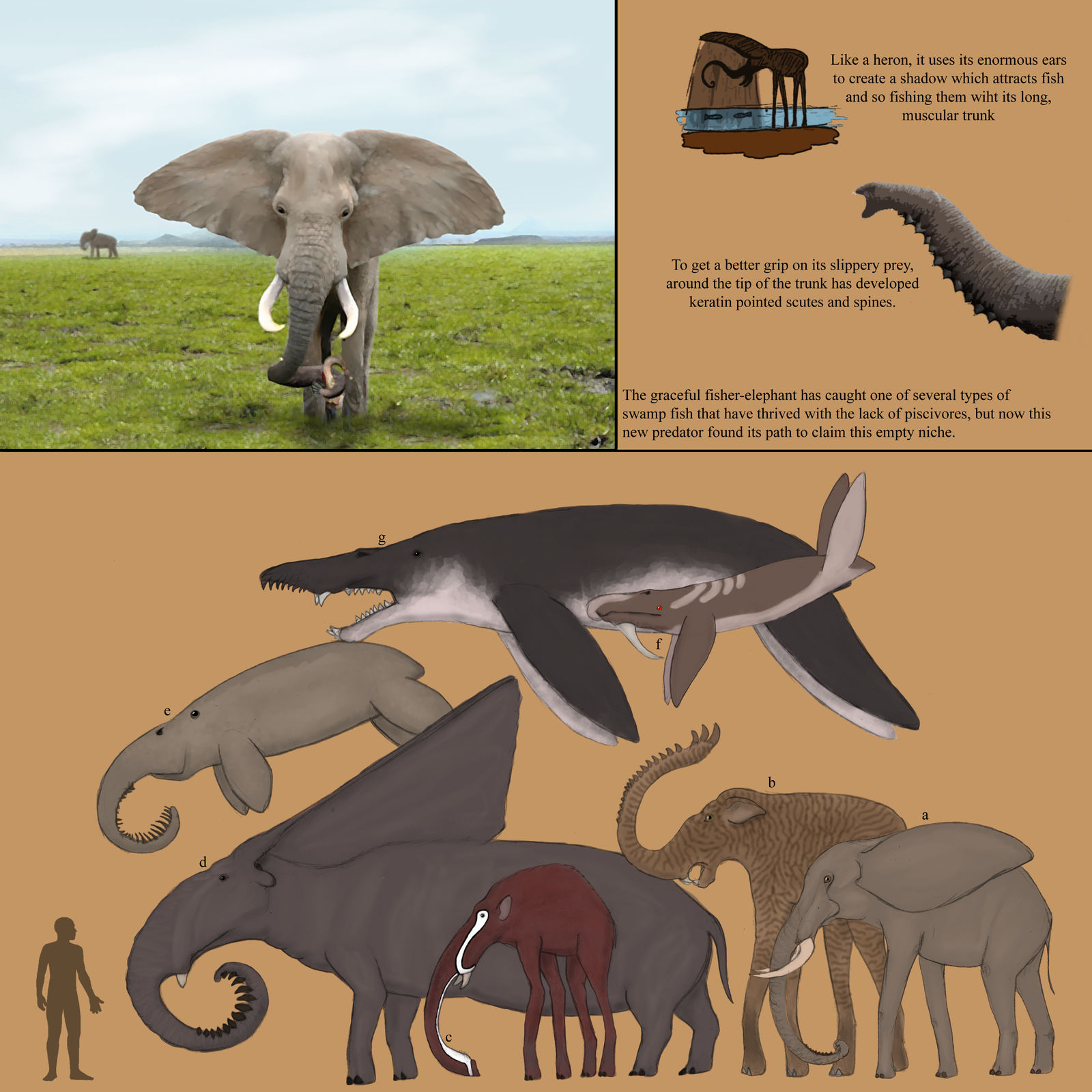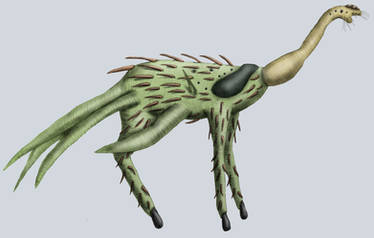Deviation Actions
Description
The terraformed worlds are probably the best places to challenge the adaptive capacities of any organisms because introduce unique conditions that could not exist in a common planet with a complex ecosystem. One of the biggest advantages is that being inhabited by a small group of species; they can expand without problems into niches in their original environments never could have taken. For elephants, this is a promising outlook for his lineage and all its possible descendants. In a terraformed planet very similar to Earth in size and climate, a very interesting ecological experiment with elephants started with the detail that is the only tetrapod inhabitant. They with a diverse set of invertebrates and a considerable amount of fish groups were abandoned to its path, and being study to look its adaptive capacities in an environment free of others animal groups, this to see their evolving abilities to such and unique conditions.
About 25 million years after colonization, elephants simply expanded across the globe and adopted different ecological niches. Many grew smaller to sizes of cows and deer, other became semiaquatic creatures similar to hippos with short legs and long bodies, and some even develop gigantic sizes, big as its extinct earth relatives. Something that began to be felt and outstand from these groups was a change in their diet from plants to other types of materials, being insectivorous or omnivorous, but these diets were not prominent enough to become carnivores. Those who took the first big leap to become specialized carnivores were a group of unique swamps dwellers that initially began to catch the small and numerous fish that were available to supplement its diet, to become piscivores. About 55 to 60 million years after the colonization of the planet, it has been enormous progress, a new mammalian lineage appeared that are entirely carnivorous, the first tetrapod predators on the planet, most descendants of the swamp piscivores, these are the Sarcoloxids.
The Sarcoloxids (Sarcoloxidae) are a weird family of proboscideans evolved from specialized forms in fisheries and exploited the different varieties of niches available, being the apex predators of most of the ecosystems. The most outstanding features is its modified trunk, which is composed by a group of specialized keratinous structures that depending on the species, they vary in shape and size. The most primitive species have a very gracile morphology compared to their herbivorous relatives, being slender, long-legged animals with compact bodies.
a) Fisherphant (Genoichtyelephas)
This is the basal form and the oldest genus of the Sarcoloxids. It have a maximum height of 2 meters, are specialized piscivores that hunt similarly to herons (more information up in the images). Like its ancestors, these are still quite social, gathering in small groups of several individuals between territories of several kilometers, mainly communicate with infrasound.
b) Terror elephant (Phoboloxida)
This is one of the first land carnivores, being gracile and fast runners, has modified the shape of the trunk scutes from short and pointed to large and rounded. This is due to the method of attack that the terror elephant use to catch any prey, beating them with its big trunk in the possible key points to knock it down. In some cases it can catch its victims with the trunk itself and try to impale or make serious lacerations with the tusks.
c) Baleenorhinchid
This is maybe one of the most unusual terrestrial forms, not only for the diet but for how it gets the food. Unlike all other species, these ones are specialized filter feeders that have atrophied the keratin scutes to the point of losing them. It feed mainly the little crustaceans, but for this, it does not use a specialized jaw as many filter feeders, instead, it used the trunk, able to keep a large volume of water, keep reaching between 15 to 25 gallons; inside have different nasal hairs which are modified to capture the small animals. After take out the water, it introduces the long tongue into the trunk to take all the small crustaceans (I know, disgusting, but food is food)
d) Spinoloxodon
This is the biggest terrestrial predator of its time, is a monstrous animal which preys giant fishes that reach lengths of 2 to 4 meters. Unlike the graceful fishers, this has a more specialized body for a semi-aquatic life with an elongated body, short and stout legs. Strangely the huge ears remained, and these modified to the point to have the function of a sail.
Orden Terapterida
Looking for the other side of thig clade, the lineages that adapted to life in water in the last 15 million years are as far the most derived clade of this group, the fully aquatic forms know as Terapterids have come to evolve in a convergent way to Pliosaurs, some even atrophied their trunks to have instead a jaw with a different shapes of teeth. Many of these develop other senses apart to perceive their environment, including some echolocation and electroreception.
e) Lipociclonus
This marine species still have a developed trunk, which is specialized to capture huge crustaceans or fishes. It belongs to the most primitive and basic groups, which have become extinct by competition. These are not great swimmers, are mainly ambush predators that are always near the seabed to be unnoticed.
f) Deinofronts
This species is one of many curious swimmers characterized by the development of strange and quite elaborate tusks which have different functions depending on the niche they occupy; in this case, the Deinofronts have developed two long lower incisors, which used both for hunting benthonic animals like molluscs and to fight with other animals. The teeth of this species are rounded and short, specialized in crushing the hard shells.
g) Saurosthanus
The nightmare of the oceans, has become the first and fiercest marine carnivores of this planet of elephant, with around 10 meters long, and with jaw as long as that of a human, it can tears apart a prey altogether with its long, pointed teeth. It is able to attack prey as big as them, using speed to attack in a precise manner; it is capable of speeds up to 60 km/h.
-------------------------------------------------------------------------------------------------------------
Well, first thank to my friends who helped me to create this concept, this idea of derived piscivorous descendants from elephants had emerged during a chat conversation on Skype after seeing elephants caught on camera that are able to catch fish with their trunks.
www.youtube.com/watch?v=1WEuDF…
www.youtube.com/watch?v=NuO2tw…
For now, this concept is not related to any project that I have, but it is likely that I will use them for any future project that will involve elephants on a terraformed planet, probably for some friend project ![]()
The Terrorphant



































